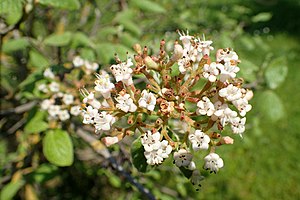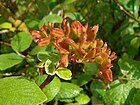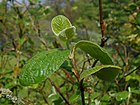Note: This is a project under development. The articles on this wiki are just being initiated and broadly incomplete. You can Help creating new pages.
Difference between revisions of "Viburnum cotinifolium"
(Created page with "{{stub}} ==Uses== {{Uses|}}, {{Uses|}}, {{Uses|}}, {{Uses|}}, {{Uses|}}, {{Uses|}}, {{Uses|}}, {{Uses|}}, {{Uses|}}, {{Uses|}}, {{Uses|}}.<ref name="Uses"/> ==Parts Used== {{...") |
|||
| Line 1: | Line 1: | ||
| − | + | [[File:Viburnum cotinifolium kz1.jpg|thumb|right]] | |
| + | '''Viburnum cotinifolium''' is a spreading, deciduous shrub that can grow up to 5 metres tall, though is often smaller in cultivation. The plant is harvested from the wild for local use as a food and source of materials. | ||
==Uses== | ==Uses== | ||
{{Uses|}}, {{Uses|}}, {{Uses|}}, {{Uses|}}, {{Uses|}}, {{Uses|}}, {{Uses|}}, {{Uses|}}, {{Uses|}}, {{Uses|}}, {{Uses|}}.<ref name="Uses"/> | {{Uses|}}, {{Uses|}}, {{Uses|}}, {{Uses|}}, {{Uses|}}, {{Uses|}}, {{Uses|}}, {{Uses|}}, {{Uses|}}, {{Uses|}}, {{Uses|}}.<ref name="Uses"/> | ||
==Parts Used== | ==Parts Used== | ||
| − | {{Parts Used| | + | {{Parts Used|Fruits}}. |
==Chemical Composition== | ==Chemical Composition== | ||
| − | <ref name="chemical composition"/> | + | It contains Extensive chromatographic separation and purification of the chloroform soluble fraction of the anti-malarial plant, Viburnum grandiflorum afforded six known compounds namely, 3-hydroxy-4,7-megastigmadiene-9-one (1), β-sitosterol (2), awabukinol (3), 1-oxo-erythrodiol (4), lupeol (5) and 10-acetylpatrinoside.<ref name="chemical composition"/> |
==Common names== | ==Common names== | ||
| Line 16: | Line 17: | ||
===Dravya=== | ===Dravya=== | ||
===Rasa=== | ===Rasa=== | ||
| − | |||
===Guna=== | ===Guna=== | ||
| Line 29: | Line 29: | ||
==Habit== | ==Habit== | ||
| − | {{Habit|}} | + | {{Habit|Deciduous Shrub}} |
==Identification== | ==Identification== | ||
| Line 48: | Line 48: | ||
==Mode of Propagation== | ==Mode of Propagation== | ||
| − | {{Propagation|}} | + | {{Propagation|Seeds}}, {{Propagation|Cuttings of soft-wood}}, {{Propagation|Cuttings of half-ripe wood}}, {{Propagation|Cuttings of mature wood}}, {{Propagation|Air layering}}. |
==How to plant/cultivate== | ==How to plant/cultivate== | ||
| − | <ref name="How to plant/cultivate"/> | + | Viburnum cotinifolium is hardy to about -15°c.<ref name="How to plant/cultivate"/> |
==Commonly seen growing in areas== | ==Commonly seen growing in areas== | ||
| − | {{Commonly seen|}}, {{Commonly seen|}}, {{Commonly seen|}}, {{Commonly seen|}}, {{Commonly seen|}}. | + | {{Commonly seen|Forests}}, {{Commonly seen|Shrubberies}}, {{Commonly seen|Affecting open spaces}}, {{Commonly seen|Mixed Abies}}, {{Commonly seen|Quercus forests}}. |
==Photo Gallery== | ==Photo Gallery== | ||
<gallery class="left" caption="" widths="140px" heights="140px"> | <gallery class="left" caption="" widths="140px" heights="140px"> | ||
| − | + | Viburnum cotinifolium 2017-05-31 1542.jpg | |
| + | Viburnum cotinifolium 2017-05-31 1543.jpg | ||
| + | Viburnum cotinifolium 2017-05-31 1544.jpg | ||
| + | Viburnum cotinifolium kz1.jpg | ||
| + | Viburnum cotinifolium - Smoketree Leaved Viburnum on way from Gangria to Govindghat at Valley of Flowers National Park - during LGFC - VOF 2019 (3).jpg | ||
| + | Viburnum cotinifolium - Smoketree Leaved Viburnum on way from Gangria to Govindghat at Valley of Flowers National Park - during LGFC - VOF 2019 (4).jpg | ||
</gallery> | </gallery> | ||
| Line 64: | Line 69: | ||
<references> | <references> | ||
| − | <ref name="chemical composition">[ | + | <ref name="chemical composition">[Chemical constituents]</ref> |
| − | <ref name="Leaf">[ | + | <ref name="Leaf">[Morphology]</ref> |
| − | <ref name="How to plant/cultivate">[ | + | <ref name="How to plant/cultivate">[http://temperate.theferns.info/plant/Viburnum+cotinifolium Cultivation]</ref> |
<ref name="Uses">Indian Medicinal Plants by C.P.Khare</ref> | <ref name="Uses">Indian Medicinal Plants by C.P.Khare</ref> | ||
</references> | </references> | ||
==External Links== | ==External Links== | ||
| − | * [ ] | + | * [http://www.flowersofindia.net/catalog/slides/Smoketree%20Leaved%20Viburnum.html Viburnum cotinifolium on flowersofindia.net] |
| − | * [ ] | + | * [https://pfaf.org/user/Plant.aspx?LatinName=Viburnum+cotinifolium Viburnum cotinifolium on pfaf.org] |
| − | + | ||
[[Category:Herbs]] | [[Category:Herbs]] | ||
Latest revision as of 15:40, 1 September 2020
Viburnum cotinifolium is a spreading, deciduous shrub that can grow up to 5 metres tall, though is often smaller in cultivation. The plant is harvested from the wild for local use as a food and source of materials.
Contents
- 1 Uses
- 2 Parts Used
- 3 Chemical Composition
- 4 Common names
- 5 Properties
- 6 Habit
- 7 Identification
- 8 List of Ayurvedic medicine in which the herb is used
- 9 Where to get the saplings
- 10 Mode of Propagation
- 11 How to plant/cultivate
- 12 Commonly seen growing in areas
- 13 Photo Gallery
- 14 References
- 15 External Links
Uses
[[:Category:Ayurvedic Herbs known to be helpful to treat |]], [[:Category:Ayurvedic Herbs known to be helpful to treat |]], [[:Category:Ayurvedic Herbs known to be helpful to treat |]], [[:Category:Ayurvedic Herbs known to be helpful to treat |]], [[:Category:Ayurvedic Herbs known to be helpful to treat |]], [[:Category:Ayurvedic Herbs known to be helpful to treat |]], [[:Category:Ayurvedic Herbs known to be helpful to treat |]], [[:Category:Ayurvedic Herbs known to be helpful to treat |]], [[:Category:Ayurvedic Herbs known to be helpful to treat |]], [[:Category:Ayurvedic Herbs known to be helpful to treat |]], [[:Category:Ayurvedic Herbs known to be helpful to treat |]].[1]
Parts Used
Chemical Composition
It contains Extensive chromatographic separation and purification of the chloroform soluble fraction of the anti-malarial plant, Viburnum grandiflorum afforded six known compounds namely, 3-hydroxy-4,7-megastigmadiene-9-one (1), β-sitosterol (2), awabukinol (3), 1-oxo-erythrodiol (4), lupeol (5) and 10-acetylpatrinoside.[2]
Common names
| Language | Common name |
|---|---|
| Kannada | |
| Hindi | |
| Malayalam | |
| Tamil | |
| Telugu | |
| Marathi | |
| Gujarathi | |
| Punjabi | |
| Kashmiri | |
| Sanskrit | |
| English |
Properties
Reference: Dravya - Substance, Rasa - Taste, Guna - Qualities, Veerya - Potency, Vipaka - Post-digesion effect, Karma - Pharmacological activity, Prabhava - Therepeutics.
Dravya
Rasa
Guna
Veerya
Vipaka
Karma
Prabhava
Habit
Identification
Leaf
| Kind | Shape | Feature |
|---|---|---|
Flower
| Type | Size | Color and composition | Stamen | More information |
|---|---|---|---|---|
| {{{5}}} |
Fruit
| Type | Size | Mass | Appearance | Seeds | More information |
|---|---|---|---|---|---|
Other features
List of Ayurvedic medicine in which the herb is used
Where to get the saplings
Mode of Propagation
Seeds, Cuttings of soft-wood, Cuttings of half-ripe wood, Cuttings of mature wood, Air layering.
How to plant/cultivate
Viburnum cotinifolium is hardy to about -15°c.[4]
Commonly seen growing in areas
Forests, Shrubberies, Affecting open spaces, Mixed Abies, Quercus forests.
Photo Gallery
References
- ↑ Indian Medicinal Plants by C.P.Khare
- ↑ [Chemical constituents]
- ↑ [Morphology]
- ↑ Cultivation
External Links
- Ayurvedic Herbs known to be helpful to treat
- Herbs with Fruits used in medicine
- Habit - Deciduous Shrub
- Index of Plants which can be propagated by Seeds
- Index of Plants which can be propagated by Cuttings of soft-wood
- Index of Plants which can be propagated by Cuttings of half-ripe wood
- Index of Plants which can be propagated by Cuttings of mature wood
- Index of Plants which can be propagated by Air layering
- Herbs that are commonly seen in the region of Forests
- Herbs that are commonly seen in the region of Shrubberies
- Herbs that are commonly seen in the region of Affecting open spaces
- Herbs that are commonly seen in the region of Mixed Abies
- Herbs that are commonly seen in the region of Quercus forests
- Herbs






